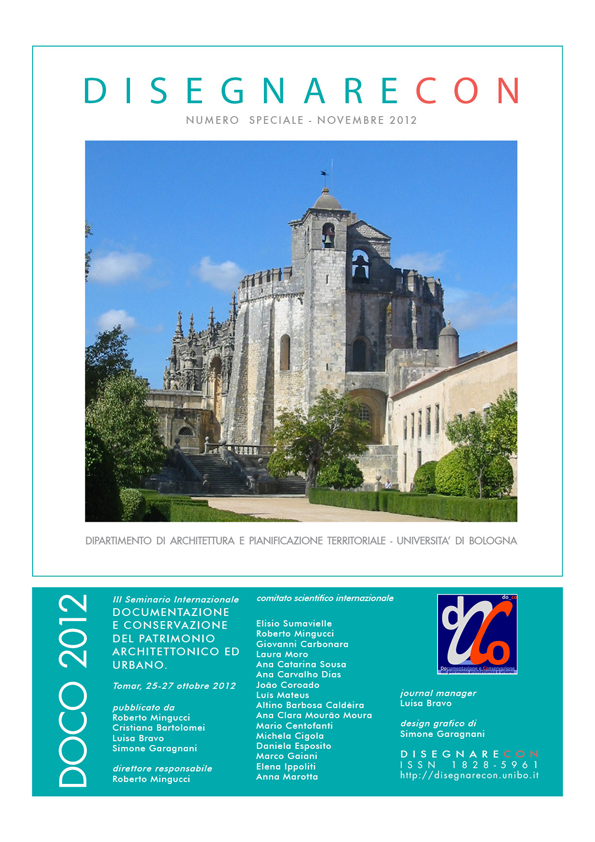Rappresentare geometria forma e materia di una facciata complessa: la chiesa di San Placido a Catania
DOI:
https://doi.org/10.6092/issn.1828-5961/3351Parole chiave:
modellazione 3D, architettura barocca, analisi geometrica, ricostruzione 3D, superfici complesseAbstract
Il presente studio indaga le potenzialità, i limiti e i vantaggi del modello ottenuto da laser scanner 3D per la documentazione e lo studio geometrico, formale, materico di una facciata storica complessa quale quella della chiesa settecentesca di San Placido a Catania, anche al fine di individuare possibili protocolli per la modellazione e gestione dei dati. Le elaborazioni condotte hanno impegnato il gruppo di ricerca nell’esplorazione dei modelli digitali tridimensionali che ne derivano e che rappresentano, ognuno con la propria specificità, la geometria e la misura, la forma e la materia.
Riferimenti bibliografici
Adami A., Fregonese, L. & Taffurelli, L. (2011). A range based method for complex facade modelling. International Archives of Photogrammetry, Remote Sensing and Spatial Information Sciences, Volume 36 (5).
Andreozzi, A., Barnobi, L., Colaiacovo, C., Giuffrida, A., Santagati, C. (2004). Il modello nella rappresentazione delle opere architettoniche e archeologiche. In E-arcom 2004 Tecnologie per comunicare l’architettura. Ancona: Clua edizioni.
Benedetti, B., Gaiani, M., Remondino, F. (eds) (2009). Modelli digitali 3D in archeologia: il caso di Pompei. Pisa: Edizioni della Normale.
Baldissini, S, Beltramini, G., Gaiani, M. (2008). The Andrea Palladio’s The Four Book of Architecture as Rich Internet Application. In Digital media and its applications in cultural heritage. Amman: CSAAR Press.
Barnobi, L. (2007). Il rilievo della Badia di Sant’Agata. In Il Rilievo dei Beni Architettonici ed Archeologici. Giornate di studio su Le nuove frontiere del rilevamento digitale Esperienze del passato e prospettive. Atti Convegno 2005. Roma: Aracne.
Böhm, J., Haala, N., Becker, S., (2007). Façade modelling for historical architecture. International Archives of Photogrammetry, Remote Sensing and Spatial Information Sciences, volume 36 (5) XXI International CIPA Symposium, 01-06 October, Athens, Greece.
Boscarino, S., (1961). Studi e rilievi di architettura siciliana, Messina.
Boscarino, S., (1981). Sicilia barocca architettura e città 1610-1760, Roma.
Chiavoni, E., Paolini, P. (eds) (2007). Metodi e tecniche integrate di rilevamento per la realizzazione di modelli virtuali dell'architettura della città. Roma: Gangemi editore.
Dato, G., Pagnano, G. (1997). Sebastiano Ittar: un architetto polacco a Catania. In L'architettura del Settecento in Sicilia. Palermo.
De Luca, L. (2006). Relevé et multi-représentations du patrimoine architectural Définition d'une approche hybride de reconstruction d'édifices. Thèse de l’ecole doctorale Arts et Metiers ParisTech, Aix-en-Provence, mars 2006.
De Luca, L., Véron, P., Florenzano, M., (2007). A generic formalism for the semantic modeling and representation of architectural elements. The Visual Computer, vol. 23, no. 3, March.
Docci, M., (ed) 2006, Metodologie innovative integrate per il rilevamento dell’Architettura e dell’Ambiente. Roma: Gangemi editore.
Gaiani, M., (2005). The digitization of architectural document repositories: a method applied to the Andrea Palladio case of study. In Multimedia.Information@DEsign for Cultural Heritage - MIDECH 2005 proceedings. Roma: Aracne.
Galizia, M., Santagati, C. (2011). 3D virtual reconstruction of an urban historical space: a consideration on the method. International Archives of Photogrammetry, Remote Sensing and Spatial and Information Sciences, volume 38 (5).
Guidi, G., Russo, M., Beraldin, J.A., (2010). Acquisizione 3D e modellazione poligonale. McGraw-Hill Companies.
Inzerillo, L., (2004). Disegnare è comunicare. In Congresso Uid Il Progetto Del Disegno. Lerici.
Lo Turco, M., Sanna, M., (2009). Digital modelling for architectural reconstruction. the case study of the Chiesa Confraternita della Misericordia in Turin. In XXIIth International CIPA Symposium. Kyoto, Japan, 11th-15th October 2009.
Migliari, R., (2001). Frontiere del rilievo: dalla matita alle scansioni 3D. Roma: Gangemi editore.
Migliari, R., (2004). Per una teoria del rilievo architettonico. In Disegno come Modello. Roma: Kappa.
Magnano di San Lio, E., (2012). The perfect proportion. In Less More Architecture Design Landscape. Le vie dei Mercanti _ X Forum Internazionale di Studi X, Collana Fabbrica della Conoscenza 16. Napoli: La Scuola di Pitagora Editrice.
Nothegger, C., Dorninger, P. (2009). 3D Filtering of High-Resolution Terrestrial Laser Scanner Point Clouds for Cultural Heritage Documentation. Photogrammetrie - Fernerkundung - Geoinformation, Volume 2009, Number 1, February 2009 (11), E. Schweizerbart'sche Verlagsbuchhandlung
Santagati, C., (2007). Il reale e la sua rappresentazione attraverso l’informatica. Enna: Il Lunario.
Santagati, C., (2008). 3D Laser Scanner Model for Stones Materials Decay Mapping. In Digital Media and its applications in Cultural Heritage. Amman: CSAAR Press.
Downloads
Pubblicato
Come citare
Fascicolo
Sezione
Licenza
Copyright (c) 2012 Mariateresa Galizia, Cettina Santagati, Graziana D'Agostino
Questa rivista è distribuita con licenza Creative Commons Attribuzione - Non commerciale 3.0 Unported.





